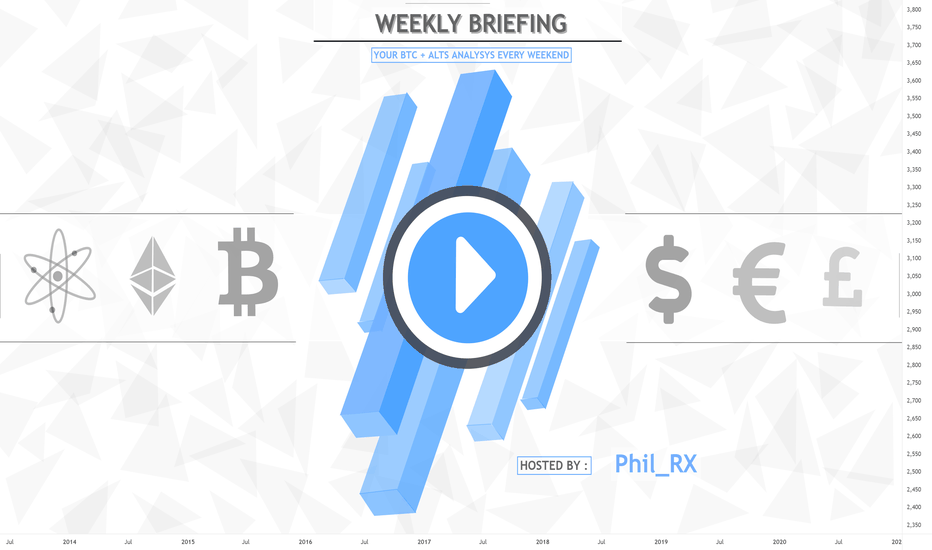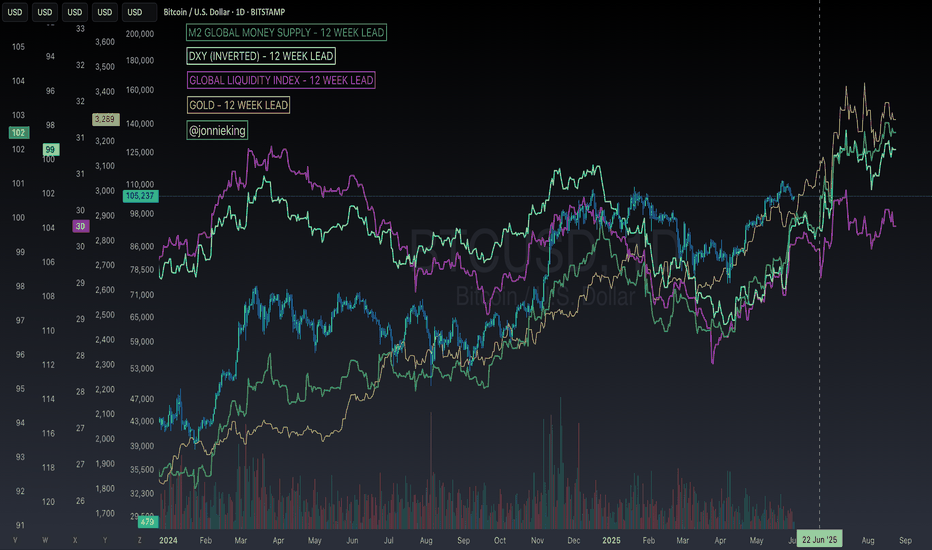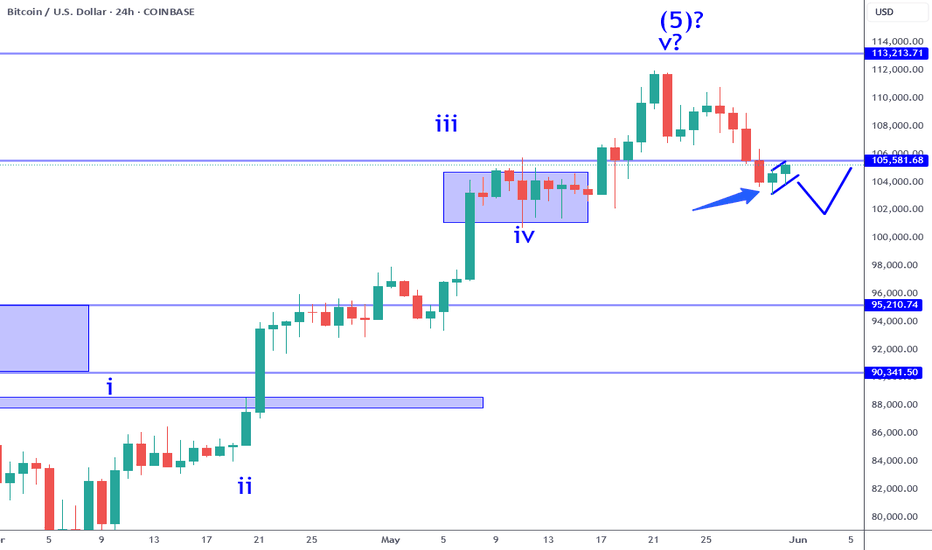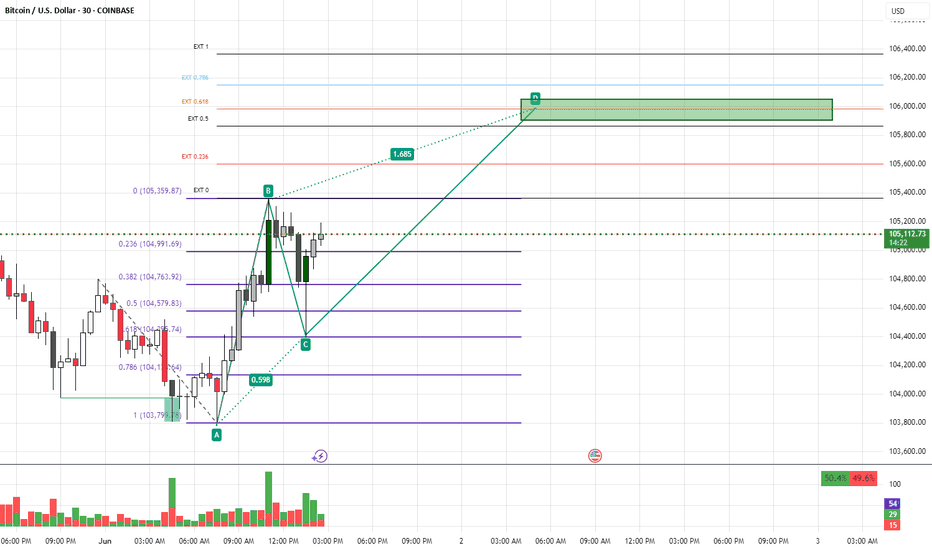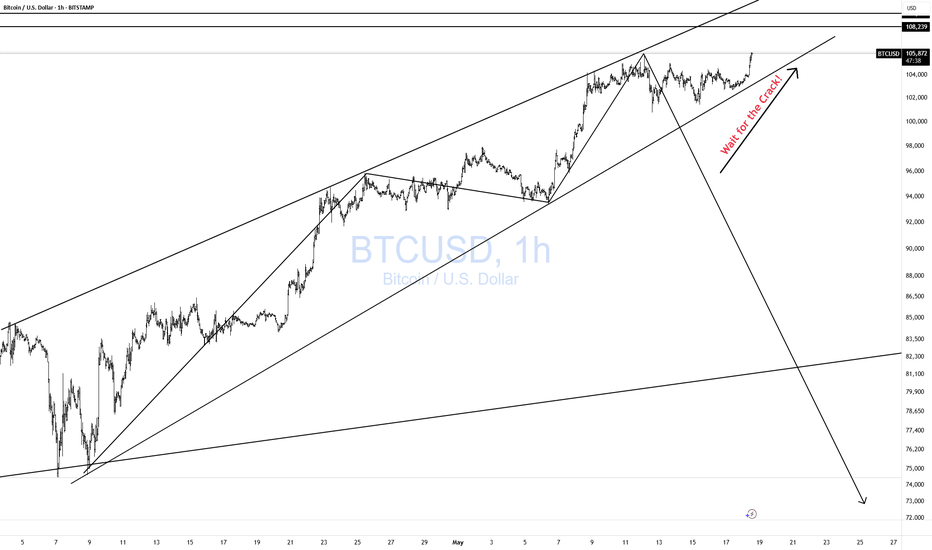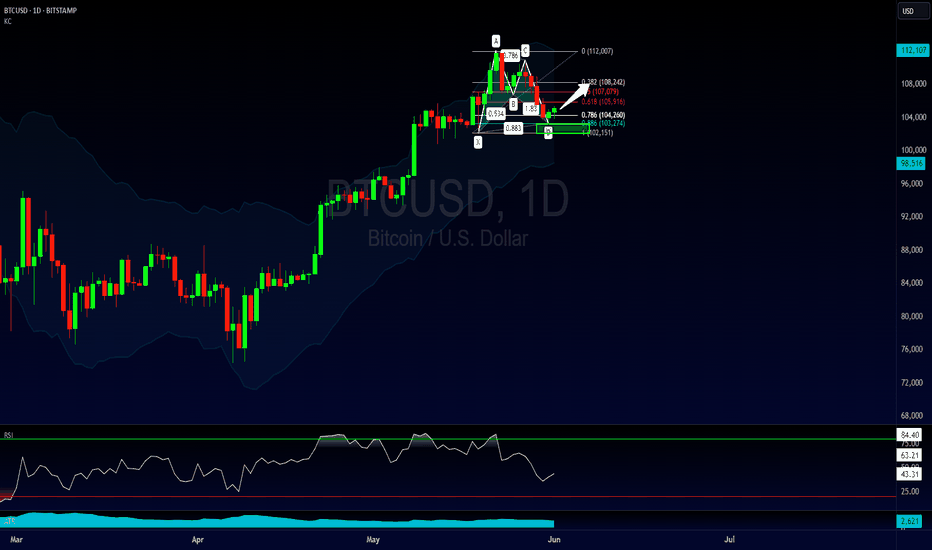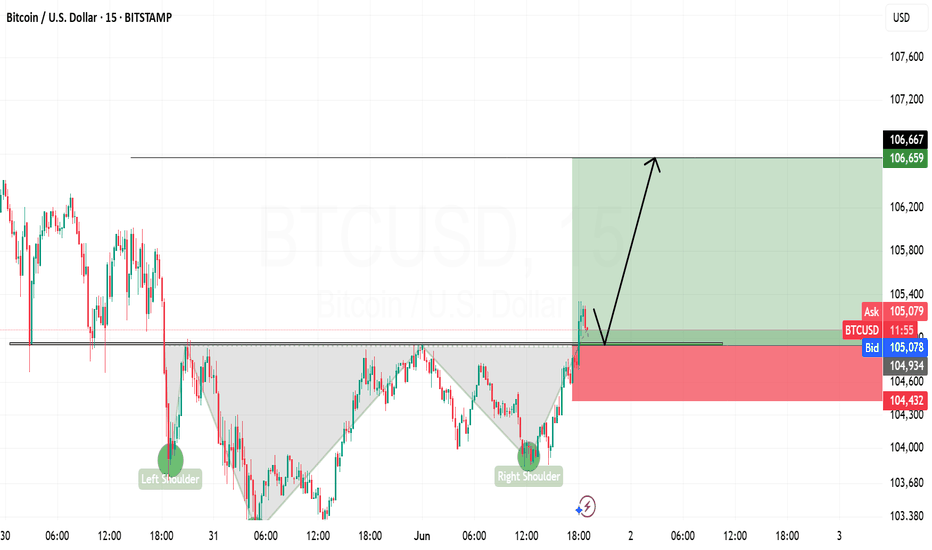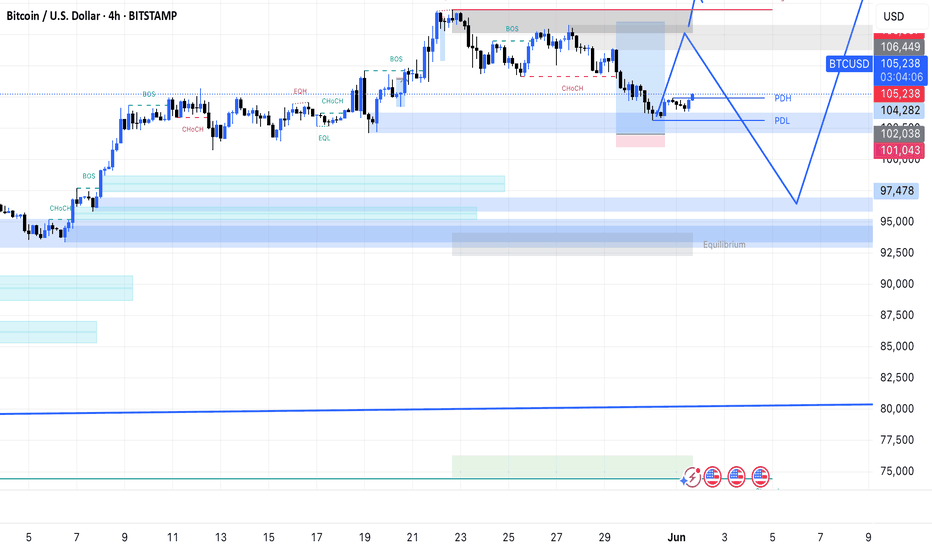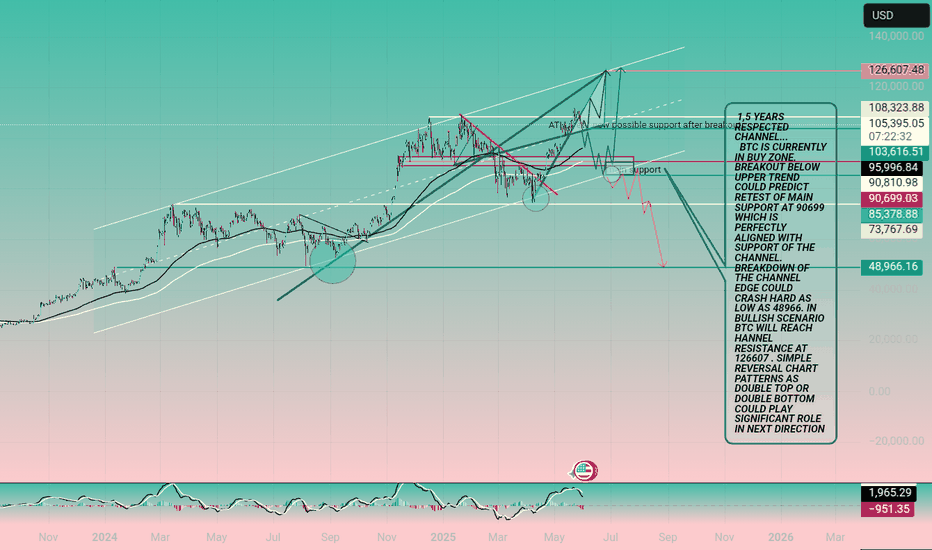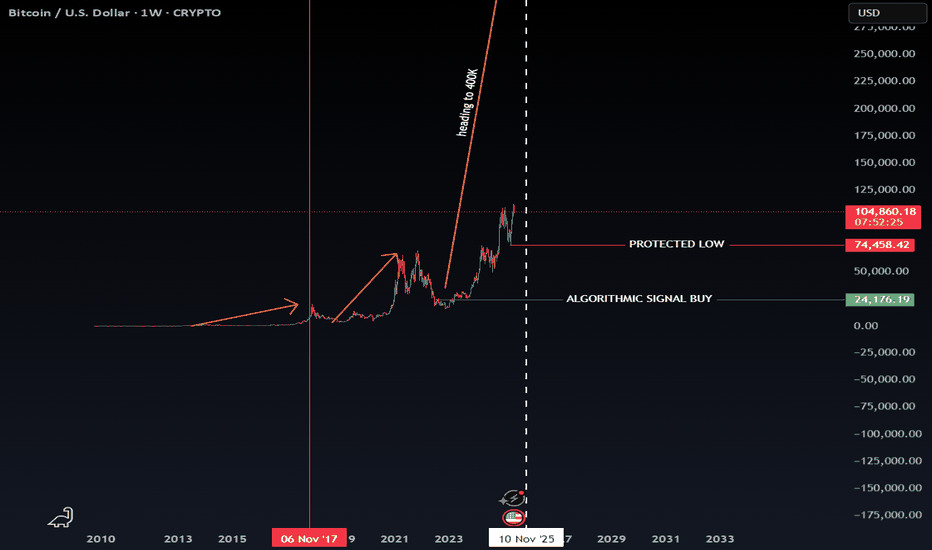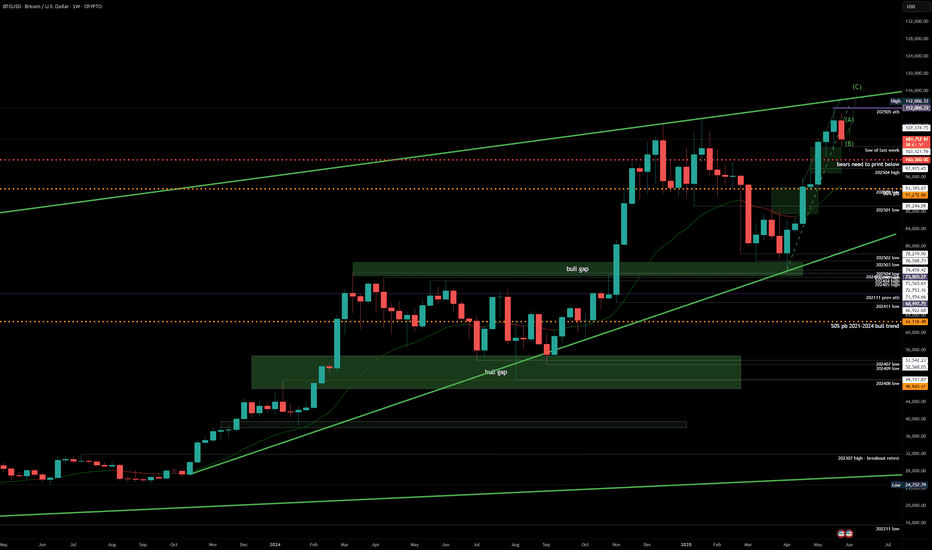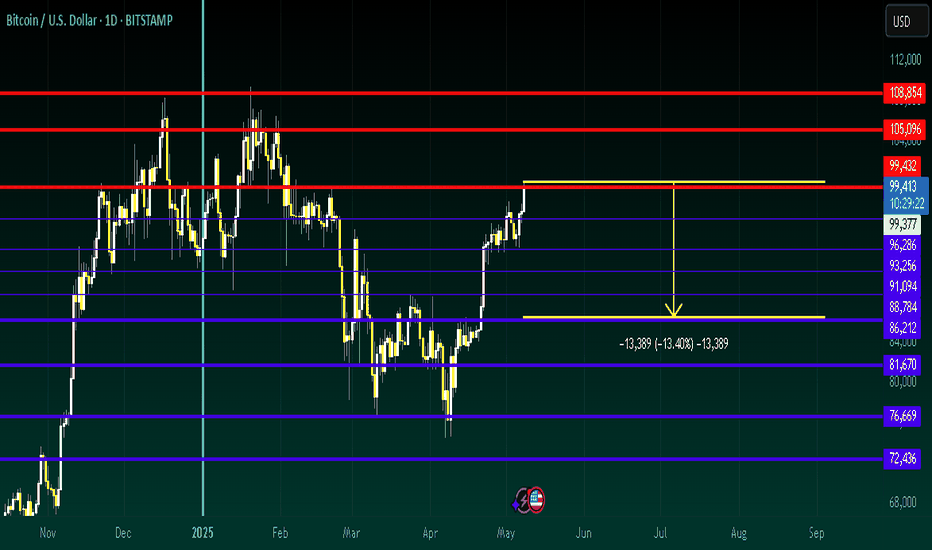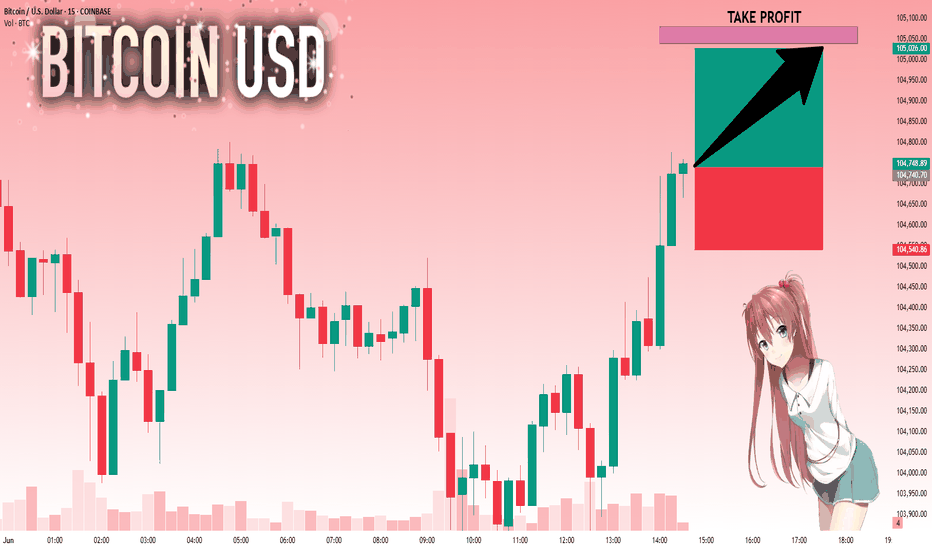Trade Analysis (BTC/USD Long Trade – 30m chart)!Trade Setup Summary
Trade Type: Long (Buy)
Entry Price: ~105,067 (current level)
Stop Loss: ~104,581 (white horizontal support)
Target Price: ~106,983 (green resistance)
Risk-to-Reward Ratio: Excellent (approx. 1:3+)
🔍 Technical Highlights
Ascending Triangle Breakout: The price was compressing in a triangle; it seems to have broken out just above the yellow resistance.
Key Resistance Levels:
Immediate resistance: 105,831 (red line – might be retested)
Target resistance: 106,983 (green line – take-profit zone)
Support Zone: 104,581 – solid level for stop-loss placement.
📌 Trade Confidence Signals
📊 Breakout from a mini ascending triangle.
📈 Volume is slightly increasing.
🟡 Previous resistance flipped into potential support.
BTCUSD.PI trade ideas
BRIEFING Week #22 : Still waiting for OilHere's your weekly update ! Brought to you each weekend with years of track-record history..
Don't forget to hit the like/follow button if you feel like this post deserves it ;)
That's the best way to support me and help pushing this content to other users.
Kindly,
Phil
Unmasking the "Intrinsic Value" Debate Between Gold vs BTCFool's Gold? Unmasking the "Intrinsic Value" Debate Between Gold and Bitcoin
The assertion is a familiar one, a well-worn cudgel in the ongoing debate between traditional assets and their digital counterparts: "Gold has intrinsic value that Bitcoin doesn't." This statement often serves as the bedrock for arguments championing the yellow metal's timeless appeal while dismissing cryptocurrency as mere speculative froth. But what if this foundational claim, this appeal to gold's inherent, undeniable worth, is built on shakier ground than its proponents believe? What if the very notion of "intrinsic value" as applied to these assets is a misunderstanding, a convenient narrative rather than an objective truth?
This exploration will journey into the heart of this debate, dissecting the concept of intrinsic value and examining how it truly applies – or doesn't – to both gold and Bitcoin. We will scrutinize gold's much-vaunted industrial utility against the backdrop of its vast above-ground stocks and its overwhelming monetary premium. We will consider whether value is indeed an inherent property of an object or a subjective judgment made by individuals. Ultimately, by challenging long-held assumptions, we aim to illuminate the real sources of value for both the ancient metal and the modern digital asset, moving beyond simplistic labels to a more nuanced understanding.
1. The Elusive Nature of "Intrinsic Value"
Before we can meaningfully discuss whether gold or Bitcoin possesses intrinsic value, we must grapple with the term itself. In the realm of corporate finance, "intrinsic value" refers to the fundamental worth of a company, derived from an analysis of its assets, earnings potential, cash flows, and overall financial health. It's an attempt to ascertain what a stock should be worth, independent of its fluctuating market price. This is the world of discounted cash flow models and balance sheet scrutiny.
However, this definition struggles when applied to commodities or currencies. Gold, like Bitcoin, does not generate cash flows. It doesn't pay dividends or have earnings reports. As one observer noted, gold and Bitcoin are commodities that have a spot price; their "value" is essentially what someone is willing to pay for them at a given moment. Companies, by contrast, can have an intrinsic value tied to the future economic benefits they are expected to produce for their owners.
So, when advocates claim gold has intrinsic value, they are often pointing to something else entirely. Usually, this encompasses its tangible, physical nature – you can hold it, feel its weight. It also refers to its historical use as money and a store of value over millennia. And crucially, it implies a baseline worth derived from its utility in practical applications, particularly in industry. One might even argue, as some have, that there is simply "no such thing as intrinsic value" in an absolute sense; value is not a property embedded within an object but is assigned to it by human beings.
2. Gold's Industrial Utility: A Gilded Facade?
The argument that gold's industrial use underpins its intrinsic value is perhaps the most frequently cited. "But it's used in microchips!" is a common, almost reflexive, defense. And it's true: gold's excellent conductivity, resistance to corrosion, and malleability make it a valuable component in high-end electronics, dentistry, aerospace, and certain medical applications. But the critical question is not whether gold has industrial uses, but how much these uses contribute to its overall market price.
Consider the data for a recent year, say 2024. Global industrial gold consumption was approximately 330 tonnes. However, a staggering 90% of this demand, around 297 tonnes, was met by recycling existing gold scrap, a process that can cost as little as tens of dollars per ounce. This leaves a mere 33 tonnes of new gold required from mining to satisfy the entirety of industrial needs not covered by recycling.
Now, compare this to the annual mine production. In that same year, about 3,700 tonnes of gold were newly extracted from the earth. This means that less than 1% (33 tonnes out of 3,700 tonnes) of all newly mined gold was actually needed for industrial purposes. The vast majority, over 99%, went elsewhere – primarily into jewelry, bars, and coins, all forms of value storage.
The disparity becomes even more dramatic when we consider the total above-ground stock of gold held for these value-storage purposes. This figure stands at roughly 184,000 tonnes. If, hypothetically, gold were to suddenly lose its allure as jewelry and its status as a monetary asset, and this colossal hoard were redirected to meet industrial needs (the 33 tonnes per year not covered by recycling), we would have enough gold to last for approximately 5,600 years at current industrial consumption rates. And this is without digging a single new ounce out of the ground. Much of this 184,000-tonne supply could potentially be acquired at prices far closer to the low cost of recycling than the current market price of newly mined gold.
As one commenter aptly put it, if gold's value was solely based on industrial demand, it "would be nearly worthless" compared to its current valuation. While gold does possess certain unique properties that make it useful, these applications are a drop in the ocean when explaining its price. The idea that its utility in microchips or dental fillings provides a significant "floor" for its value is, upon closer inspection, largely a myth.
3. The Towering Monetary Premium: Where Gold's Value Truly Lies
If industrial use accounts for such a tiny fraction of gold's demand and price, what explains the rest? The answer is its "monetary premium." This is the portion of an asset's price that exceeds its direct use-value as a commodity. For gold, this premium is immense, built over centuries of human history and cultural adoption.
Gold's journey as money began thousands of years ago. Its inherent characteristics – it doesn't rust or tarnish (durability), it's relatively rare (scarcity), it's easily recognizable and has a pleasing aesthetic (acceptability), it can be melted and reformed (divisibility and fungibility), and it's dense (portability of value) – made it a superior choice for a medium of exchange and store of value in pre-industrial societies. This long history has ingrained gold into the collective human consciousness as something inherently valuable. There's a certain "magical power," as one person described it, to the shiny yellow metal, a testament to its enduring legacy.
This historical precedent and the deep-seated belief in its enduring worth are what sustain gold's monetary premium. Central banks hold it in their reserves. Individuals purchase it in the form of jewelry (which, in many cultures, serves as a primary store of family wealth) and invest in bars and coins, not primarily for its practical applications, but because they trust it will preserve purchasing power or be desired by others in the future. This shared belief, this social consensus, is the bedrock of gold's value far more than its limited industrial applications. Some estimate this monetary premium to be as high as 90% of its total price, with the remaining 10% attributable to its use in jewelry and industry.
4. The Shifting Sands of Perceived Value
The notion that value is intrinsic and immutable is challenged by history itself. Value, as many economists and observers contend, is not an inherent property of an object but is determined by human perception and utility, which can and do change over time.
Consider aluminum. There was a time when aluminum was exceedingly rare and difficult to extract, making it more precious than gold. The capstone of the Washington Monument, completed in the late 19th century, was made of aluminum to signify its value and the technological prowess of the era. Today, thanks to advancements in refining processes, aluminum is abundant and inexpensive. We use it to wrap sandwiches, a far cry from its days as a "precious" metal adorning national monuments.
Similarly, Tyrian purple dye, derived from sea snails, was once so costly and labor-intensive to produce that its use was reserved for royalty and the highest echelons of society. It symbolized power and status. The invention of synthetic dyes in the 19th century made purple accessible to everyone, and the immense value once attached to the natural version evaporated.
These examples powerfully illustrate that what society deems valuable is not fixed. It is contingent on factors like scarcity (natural or artificial), the current state of technology, cultural significance, and collective human agreement. If gold's value is predominantly a monetary premium built on historical consensus and aesthetic appeal, then it too is subject to these shifting sands of human perception. The humorous desire to one day wrap sandwiches in gold foil, should it lose its monetary status, underscores this potential for radical revaluation.
5. Bitcoin's Utility: Solving Problems of the Digital Age
If gold's claim to "intrinsic value" through industrial use is tenuous, and its primary value stems from a historically constructed monetary premium, how does Bitcoin compare? Critics often dismiss Bitcoin as having no utility beyond speculation, a digital tulip mania. However, this perspective often overlooks the specific problems Bitcoin was designed to address and the unique properties it offers in the 21st century.
Bitcoin emerged in the wake of the 2008 financial crisis as a "peer-to-peer electronic cash system," aiming to provide an alternative to the traditional financial system. Its utility lies in its ability to offer:
• Decentralization: No single entity, corporation, or government controls the Bitcoin network. It operates on a distributed ledger (the blockchain) maintained by thousands of computers worldwide. This makes it resistant to control or shutdown by any central authority.
• Permissionless Access: Anyone with an internet connection can participate in the Bitcoin network – send, receive, and store value – without needing permission from a bank or government.
• Censorship Resistance: Once transactions are confirmed and added to the blockchain, they are extremely difficult to alter or reverse. This makes it a powerful tool for individuals in environments where financial censorship is a concern.
• Provable Scarcity: The Bitcoin protocol dictates that there will only ever be a maximum of 21 million bitcoins. This hard cap on supply is a fundamental aspect of its design, making it a verifiably scarce digital asset. This contrasts with gold, where new supply is continuously mined each year, estimated by some to be around 1.5-2% of the existing above-ground stock, arguably diluting its value over time.
• Portability and Divisibility: Bitcoin is incredibly portable. Vast sums can be "carried" on a tiny device or even memorized as a seed phrase, and transferred across the globe in minutes for relatively low fees. It is also highly divisible, down to one hundred millionth of a bitcoin (a "satoshi"), facilitating transactions of various sizes.
• Verifiability: The authenticity and transaction history of every bitcoin can be publicly verified on the blockchain, eliminating the need for trust in intermediaries for this purpose.
• Durability: As a digital asset secured by a vast, decentralized network, Bitcoin is highly durable as long as the network itself remains operational and secure.
A crucial real-world utility, highlighted by observers, is Bitcoin's ability to bypass capital controls. For individuals in countries with restrictive financial regimes, Bitcoin offers a means to transact and move value across borders with a degree of freedom not possible through traditional channels. This is not a speculative feature; it is a tangible benefit solving a real problem for many.
While the number of people using Bitcoin worldwide is still relatively small compared to users of traditional financial systems, its adoption is growing. Like any transformative technology, its utility is being discovered and leveraged by an expanding user base. Its "intrinsic value," if we are to use that term, lies in its capacity to fulfill these unique functions.
6. Gold vs. Bitcoin: A Clash of Properties
When we compare gold and Bitcoin based on properties often associated with a store of value or monetary good, distinct profiles emerge:
• Tangibility: Gold is physical; you can touch it. This offers a psychological comfort that some find reassuring. Bitcoin is digital; its existence is as code and ledger entries. Its "possession" is through control of cryptographic private keys.
• Industrial Utility: Gold has limited industrial uses that account for a tiny fraction of its price. Bitcoin's "industrial utility" is the operation of its network as a global system for value transfer and verification.
• Scarcity: Gold is naturally scarce, but its total earthly and cosmic abundance is unknown, and new supply is constantly mined. Bitcoin has absolute, programmable scarcity with a fixed supply cap.
• Portability: Moving large amounts of gold is cumbersome, expensive, and risky. Bitcoin is exceptionally portable.
• Divisibility: Gold can be physically divided, but it's not a seamless process. Bitcoin is easily and precisely divisible.
• Verifiability: Authenticating gold requires specialized knowledge and tools; it can be faked. Bitcoin transactions and holdings are verifiable with mathematical certainty on its public ledger.
• Durability: Gold is physically very durable. Bitcoin, as a digital protocol, is durable as long as its decentralized network is maintained and secured.
• Historical Precedent: Gold boasts millennia of use. Bitcoin is a little over a decade old, a mere infant by comparison.
• Censorship/Seizure Resistance: Physical gold can be, and has been, confiscated. Self-custodied Bitcoin, with properly secured private keys, is highly resistant to censorship and seizure.
This comparison reveals that while gold's strengths lie in its long history and physical presence, Bitcoin excels in areas like absolute scarcity, portability, divisibility, verifiability, and censorship resistance – attributes that are arguably increasingly valuable in an increasingly digital and interconnected global landscape.
7. The "Next Person" Fallacy and the Foundation of Value
A common critique leveled at both gold (for its monetary premium) and Bitcoin is that their value depends solely on "the next person being willing to buy it." In a sense, this is true for any asset that isn't consumed directly or doesn't produce cash flows. The value of a collectible, a piece of art, or indeed a monetary good, is ultimately what someone else is prepared to exchange for it.
However, this doesn't mean their value is arbitrary or baseless. The willingness of the "next person" to buy is predicated on a shared understanding or belief in the asset's desirable properties and its potential to retain or increase its value. For gold, this belief is built on thousands of years of tradition and its perceived enduring qualities. For Bitcoin, this belief is growing based on its unique technological attributes, its potential to solve modern financial problems, and its emerging network effects. The more people who recognize and utilize these properties, the stronger the shared belief, and thus the more robust its value becomes.
8. The Cost of Production and the Illusion of a Price Floor
Some argue that gold's price cannot fall below its cost of extraction, suggesting this provides a natural price floor. While it's true that miners would cease operations if the price fell below their production costs for a sustained period, this argument largely ignores the colossal 184,000 tonnes of gold already above ground and held primarily for monetary or aesthetic purposes. If this massive hoard were to lose its monetary premium and be dumped onto the market, the price could plummet dramatically, far below current mining costs, until it reached a level where industrial demand (or perhaps a new, much lower equilibrium for aesthetic use) could absorb it. Much of this existing stock could be made available at recycling costs, which are significantly lower than mining costs. The "cost of production" floor applies primarily to newly added supply, not to the revaluation of existing, hoarded stock.
Conclusion: Beyond Intrinsic – Value in Utility and Belief
The debate over whether gold has "intrinsic value" that Bitcoin lacks often misses the mark by clinging to a nebulous and misapplied concept. If "intrinsic value" refers to a baseline worth derived from non-monetary, practical utility, then gold's claim is surprisingly weak. Its industrial applications are minimal compared to its price, which is overwhelmingly a monetary premium built on centuries of human belief, cultural acceptance, and its historical role as money.
Value, ultimately, is not an inherent property magically residing within an object. It is a subjective judgment made by individuals, a reflection of an asset's perceived utility and the collective belief in its future desirability. Gold has served humanity well as a store of value due to a set of physical properties that were optimal for pre-digital eras. Bitcoin, a product of the digital age, offers a different set of properties – provable scarcity, decentralization, censorship resistance, and unparalleled portability – that address the challenges and opportunities of our modern world.
Neither gold's sheen nor Bitcoin's bits possess a mystical "intrinsic value" independent of human perception and use. Gold's value is rooted in its long history and the enduring human affinity for its beauty and permanence. Bitcoin's burgeoning value is rooted in its innovative technology and its potential to offer a new paradigm for money and value transfer. Both are valuable because, and only because, people believe them to be. The critical difference lies in the reasons for that belief and the problems each asset is perceived to solve. As the world continues to evolve, so too will our understanding and assignment of value.
$BTC 12-Week Lead Correlation w/ Global Liquidity, M2, GOLD, DXYHere’s a look at Bitcoin's price action against Global Liquidity, Global M2, GOLD and DXY - all with a 12-Week Lead.
Notice GOLD has a bit more of a deviation from the BTC price than the others.
This is because GOLD is used as a store of value asset, whereas the others are predicated on Central Banks expanding and contracting their money supply and balance sheets.
The key here is to smooth out the signal and ignore the noise.
Notice the convergence between these metrics the past couple months.
Bitcoin: Bear Flag Formation Implies Weakness.Bitcoin has retraced as anticipated in my previous article (see Wave 5). So much for all the nonsense hype at the Bitcoin conference. Bitcoin has tested the 103K area and found some support but is developing a mini bear flag (see arrow). IF the 103,500K level is broken, that confirms the corrective structure is still in play and a test of 102 to 100K can still be the dominant scenario for the coming week (NFP this week). This means for swing traders on this time frame, it is likely too early for longs.
The 102 to 100K area is still the major support that I anticipate. A long signal here can look like a pin bar on this time frame, or a double bottom formation on a 4h or 1h chart. It often pays to wait for these scenarios but there is always a risk of missing the move if price confirms a reversal pattern sooner.
IF the current candle closes much higher (above 106K) then it will invalidate the bear flag. This means the bullish continuation would be in play. In my opinion this is a lower probability, but you have to be open to it. In the bullish scenario a test of 110 to 112 servers as a profit objective. While a breakout beyond 112 can happen, the more you expect, the more RISK you must be exposed to. A test of high is more probable than a new high. Along with that, I suspect current price action is more likely to consolidate rather than continue high over the short term because 5 waves are clearly in place. That usually means a corrective structure is likely to follow, and that is what we are currently in.
The bullish candles are too early to buy into. If the bear flag plays out, there will be more attractive prices to wait for reversal formations. Otherwise, work smaller time frames, look for small bites going either way and keep the size small. This is not an easy environment.
Bitcoin Gann Cycle Projection: 2025 Top Near 0.75?This chart applies the Gann Square of 9 over the last three Bitcoin cycles, each normalized in both time and price using log scale.
🔹 Cycle Durations:
1st cycle: 1064 days
2nd cycle: 1064 days
Current (projected): 1064 days
🔹 Cycle Tops by Time Division (of full Gann square):
Cycle 1 top: ~0.125 (1/8)
Cycle 2 top: ~0.382 (between 0.382 and 0.5)
Current cycle (2025) is projected to top near 0.75 (3/4), which historically marks the later phases of Gann harmonic progression.
🔹 Price-Time Symmetry:
All three cycles align with the Gann square grid, showing how BTC tends to follow harmonic time levels:
0.125
0.25
0.382
0.5
0.618
0.75 (projected top)
🌀 This follows a 1 → 3 → 6 harmonic expansion sequence, reflecting Gann’s time geometry more than Fibonacci.
📅 Projected top timing: Around October 20, 2025
💰 Potential price zone: ~$124,000, intersecting Gann resistance at the 0.75 time level.
BTCUSD Sellers In Panic! BUY!
My dear followers,
This is my opinion on the BTCUSD next move:
The asset is approaching an important pivot point 10489
Bias - Bullish
Safe Stop Loss - 10362
Technical Indicators: Supper Trend generates a clear long signal while Pivot Point HL is currently determining the overall Bullish trend of the market.
Goal - 10701
About Used Indicators:
For more efficient signals, super-trend is used in combination with other indicators like Pivot Points.
Disclosure: I am part of Trade Nation's Influencer program and receive a monthly fee for using their TradingView charts in my analysis.
———————————
WISH YOU ALL LUCK
A Harmonic Pattern Entry Into A Potential Continuation TradeI don't look at Bitcoin often but when answering a question for another trader this weekend I stumbled across an interesting opportunity.
Higher timeframe we've recently broken and closed above a previous high, allowing me to project that price is likely to continue higher.
We've already started to retracement in the form of a complex pullback and if you look carefully on the lower timeframe this complex pullback as also created a bullish bat pattern which could be used as an entry.
Please leave any questions or comments below
Akil
BTCUSD Hits Premium FVG – Liquidity Raid Incoming?BTCUSD | 4H Chart Breakdown – FVG, Order Block, and Smart Money Confluence
Here’s a killer SMC-based short opportunity forming on BTCUSD. Let’s decode this clean setup:
⚙️ 1. Market Structure Snapshot
Change of Character (ChoCH) confirmed on lower timeframe
Price aggressively retraced into a premium zone
Now tapping a combo zone:
✅ Fair Value Gap
✅ Order Block
✅ Sell-side OB mitigation
✅ Sitting right below Buy-Side Liquidity
We’re in prime territory for a liquidity raid followed by a sharp rejection.
📊 2. Key Price Zones
📈 Current Price: ~105,257
🟪 OB + FVG Zone: 104,766 – 105,257
🟦 Weak High (Target for Raid): ~106,200
🔻 Sell Setup Activation: If price shows rejection at OB zone
📉 Sell Target: 103,800 (Strong Low + liquidity pocket)
This is textbook bearish structure after a sweep of weak highs — time to watch the market respond.
🧠 3. SMC Logic Breakdown
ChoCH marks the first sign of bullish intent
But price is now entering a premium zone above equilibrium
Liquidity lies just above the weak high
We expect:
Raid of the weak high / buy-side liquidity
Rejection at the OB + FVG
Sharp drop to take out the strong low
This pattern = a high-probability SMC trap short.
📉 4. Risk-Reward Plan
🛑 Stop Loss: Just above 106,314.50
🎯 Take Profit: Near 103,800 (Strong Low)
🔁 RR: ~1:3 to 1:4 if you enter after a M5 rejection
🧼 Partial TP: Midway at 104,200 to reduce exposure
🧩 5. Entry Strategy
Monitor M5–M15 around OB + FVG zone
Wait for bearish engulfing / BOS
Refine entry with tighter SL
Let it play toward sell-side liquidity
⚔️ 6. Trader Notes:
Don't short early. Wait for reaction and structure shift
This is liquidity engineering – smart money lures in longs before nuking
Pair this chart with volume divergence confirmation if available
💣 Type "Liquidity Trap 💀" in the comments if this setup matches your bias
🔁 Save this if you scalp or swing SMC-based setups
🔔 Follow @ChartNinjas88 for clean smart money plays
Bitcoin about to reach the target zone On today's chart bitcoin took exact rejection from demand zone plotted by AI quant-x indicator.
We take trade either from demand rejection or from supply rejection. From demand rejection is buy trade and supply rejection is sell trade . Price exactly reversed from the demand zone now approaching the target of supply zone . Zone to zone trading
Bitcoin Wasn't Built for Bull Runs — It Was Built for This MomenDear traders,
You may be witnessing a “first” — a pivotal moment right before things begin to spiral.
We’re not fortune tellers. We don’t claim to predict the future.
But what you’re about to read is based entirely on **publicly available data**, interpreted not through speculation, but through a deep, rational analysis of interconnected facts — the kind of connections that most overlook, and few dare to question.
We may not know how the future is being orchestrated behind the scenes...
But one thing seems certain: **crisis always comes first...** and *then* we are given a **narrative** to justify it — be it war, a pandemic, or a "global emergency."
This is the correct sequence... and it’s the one they never teach you.
Yet for those of us who navigate the financial markets, one question matters more than all others:
**How do we profit from this?**
---
We recently shared an important setup on the **Nasdaq index**, the benchmark that reflects — to a large extent — the true state of the U.S. economy.
As a proxy for the 100 largest American corporations, the Nasdaq plays a critical role in signaling macro trends.
And while some are just now waking up to the storm ahead, **our outlook has been clear since October 2022**:
A major economic crisis was not only probable… it was **inevitable**.
Some analysts chalk this up to uncontrolled money printing post-2019 as governments tried to patch the damage from the COVID-19 crisis. That’s one explanation.
But at **Glich**, our vision is different.
More complex.
And for now… **not something we can fully release**.
---
For years, strong correlations between **risk markets** — especially U.S. equities and crypto — held firmly in place.
But something changed on **May 30th, 2025**. Completely and unmistakably.
The link was severed.
Now ask yourself:
**Why was Bitcoin created in the first place?**
It wasn’t just digital money.
It was a bold, revolutionary idea. A system designed for a future economy no longer shackled by inflation, central banking failures, or hidden agendas.
A fluid, transparent, and secure network for a world in desperate need of change.
The current financial model is obsolete. It’s no longer evolving — just surviving.
And it can no longer answer the challenges of what's to come.
**2008 was not the collapse; it was the setup.** A convenient pretext to slowly roll out something **new**.
And "Satoshi Nakamoto"? Well, let’s just say...
**That name means more than you think.**
_"HIDDEN INFORMATION"_ 👁️
---
What does NEO mean when he says:
> "This has all happened before… yet it’s happening for the first time"?
And what does that have to do with us?
This analysis is *not* just about charts or setups.
It’s a **hidden message** — a spotlight on a once-in-a-generation opportunity lying in plain sight.
But not everyone is trained to read between the lines.
---
Let us ask:
- Why was **Donald Trump** specifically pushed into position?
- Why is crypto — after being suppressed, banned and attacked worldwide — now being quietly **promoted** and fast-tracked in legislation during 2024 and 2025?
Something’s moving beneath the surface.
---
### 🔍 In summary:
- Expect a tidal wave of **global crypto legislation** to pass in the coming **days/weeks/months**.
- Crypto — particularly **BTC and ETH** — will become silent **stores of value** during the economic storm.
- Expect record-breaking levels: **$400K for Bitcoin**, **$40K for Ethereum**.
Yes, this may sound like science fiction…
But keep your eyes and ears wide open. 👁️
- And brace yourself for a **historic collapse** in U.S. equities. Possibly… something we’ve never seen before.
---
The show is starting.
And we won’t spoil the ending — because watching it unfold is part of the experience.
But here’s what we *can* say, thanks to our proprietary **algorithmic system**:
- The **U.S. economy will bleed**.
- And crypto will blow past expectations — fulfilling the very purpose it was built for.
---
🛒 Load your bags in the coming days...
Because when this train leaves the station —
It won't be stopping for anyone.
#202522 - priceactiontds - weekly update - bitcoinGood Day and I hope you are well.
comment: First weekly bear bar since end of March but I doubt we just go down. Much more likely is a trading range until more bulls doubt we get above 112k. Can you buy 103k? Only with a stop maybe 98k since the risk of hitting 99.9k are too big to have a stop there. But that trade is much more likely to succeed than shorting 103k with a stop 112.1k.
current market cycle: Broad bull channel on the weekly and monthly chart. Tight bull channel on the daily chart break this week and we are likely in a trading range before we get the next impulse.
key levels: 100k - 115k
bull case: If you are still long this and have not taken profits at 110k, I don’t know what you are waiting for. Market is clearly not finding buyers above 110k and it’s a perfect double top with 2024-12 and 2025-01. Can we hit 115k oder 120k? Sure but the odds are so low. If you are HODLing for 1mil, will hold through 70k again and buy more? If so, good luck to you. Got nothing for the bulls other than a trading range.
Invalidation is a daily below 100k with follow-through.
bear case: Bears need a gap down and it has to stay open if they want more downside. I think the selling this week was decent and without much resistance by the bulls. Contraire to nq and sp500, Friday did not produce a big reversal, which makes me a bit more bearish than it probably should. We are at bigger prior support and I can only really favor the bears once we close the gap down to 97k and the April high.
Invalidation is above 116k.
short term: Neutral. I expect a trading range and likely another test of 110k or even 115k but this will likely be the double top many are waiting before they will short this. A very rough guess of another two-legged move higher is on the chart but don’t trade based on that as of now. Wait for stronger buying again and be prepared to not get more than 110k.
medium-long term - Update from 2025-05-25: Will update this next week but plan here is the same as other markets. I wait for this to top out and trade it back down to 80k over the summer.
Bitcoin Wyckoff Distribution Complete – Markdown Phase Ahead?This chart is a technical analysis of **Bitcoin (BTC/USD)** on the **4-hour timeframe** from Binance, illustrating **Wyckoff Market Cycle Phases** applied to recent price action.
### 🧠 Chart Description:
The chart identifies and labels key **Wyckoff phases**:
* **Accumulation (April)**: Price consolidates in a range after a downtrend. This phase marks strong hands accumulating Bitcoin from weak hands.
* **Reaccumulation (late April to early May)**: A bullish continuation pattern where the price pauses temporarily before resuming the uptrend.
* **Distribution (mid-May)**: The price enters another consolidation phase, but this time smart money begins offloading holdings at elevated prices to retail traders.
### 📉 Projected Move:
* A breakdown below the current support is anticipated, leading to a **markdown phase**.
* The red path suggests a significant decline, potentially toward the **\$85,000–\$90,000 range**, indicating bearish momentum.
* After the markdown, **accumulation is expected to resume**, setting the stage for the next potential markup.
### 📊 Supporting Visual:
On the right side, there's a reference schematic titled **“Market Phases” by Readtheticker.com**, which summarizes:
* Accumulation → Markup → Distribution → Markdown → Accumulation cycle.
* It also highlights buying/selling pressure dynamics and behavioral patterns at each phase.
---
BITCOIN PESSIMIST ROUND 3: Fool me 3 times3rd time now and hopefully the last
ranging and weaker impulse after every reversal i marked on goes to show slowing in velocity its time folks
i hope so
levels of resistance in 2 pxl 4 pxl revesal but anything could happen at those resistance and it could revese stay tuned
BTCUSD: Bulls Are Winning! Long!
My dear friends,
Today we will analyse BTCUSD together☺️
The recent price action suggests a shift in mid-term momentum. A break above the current local range around 104,740.70 will confirm the new direction upwards with the target being the next key level of 105,037.78 and a reconvened placement of a stop-loss beyond the range.
❤️Sending you lots of Love and Hugs❤️

